 Web Front-end
Web Front-end
 JS Tutorial
JS Tutorial
 Detailed explanation of the difference between :first-child, :first and :first-of-type in jQuery selectors
Detailed explanation of the difference between :first-child, :first and :first-of-type in jQuery selectors
Detailed explanation of the difference between :first-child, :first and :first-of-type in jQuery selectors
Let’s start with a little digression. Because my first job after graduation was not a front-end job, it was in a state-owned enterprise. After working for about 3 months, I really couldn’t stand the comfortable pace of life, so I resigned decisively (actually because of the lack of money), and then I chose Decide on the direction you like and start from the page. So now it is almost the third month of working as a page boy. Because I found an internship at a small start-up company, I actually have relatively little knowledge about the front-end from beginning to end. I usually just check and learn whatever I need. , so I can only look for jQuery API recently.
Okay, let’s get to the point.
I saw the :first-child selector in the API, which is described in this way (I used someone else’s translation and compilation, but I still feel like reading the official English version It's better, but I still use this version because I'm lazy)
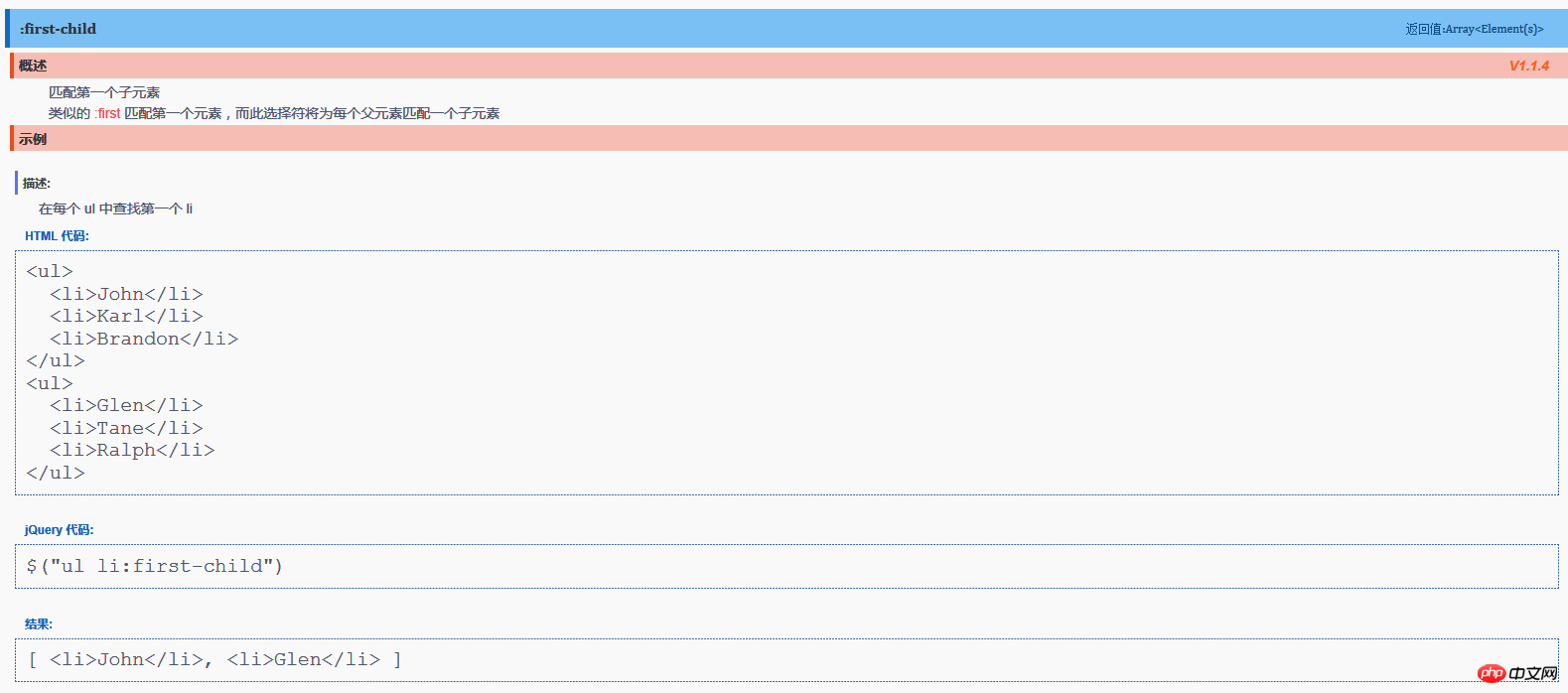
Regarding this, I was very annoyed at first, because what is returned is an array# of an object ## (I personally understand this, I don’t know if it is correct), but the name of this selector is: first-child (I really feel like complaining, why don’t I call it children). Later, I tried it myself and found that if I don’t use each( ) is traversed, the first element of the array is returned by default, which is
:first-of-type, as follows It’s his description of this selector
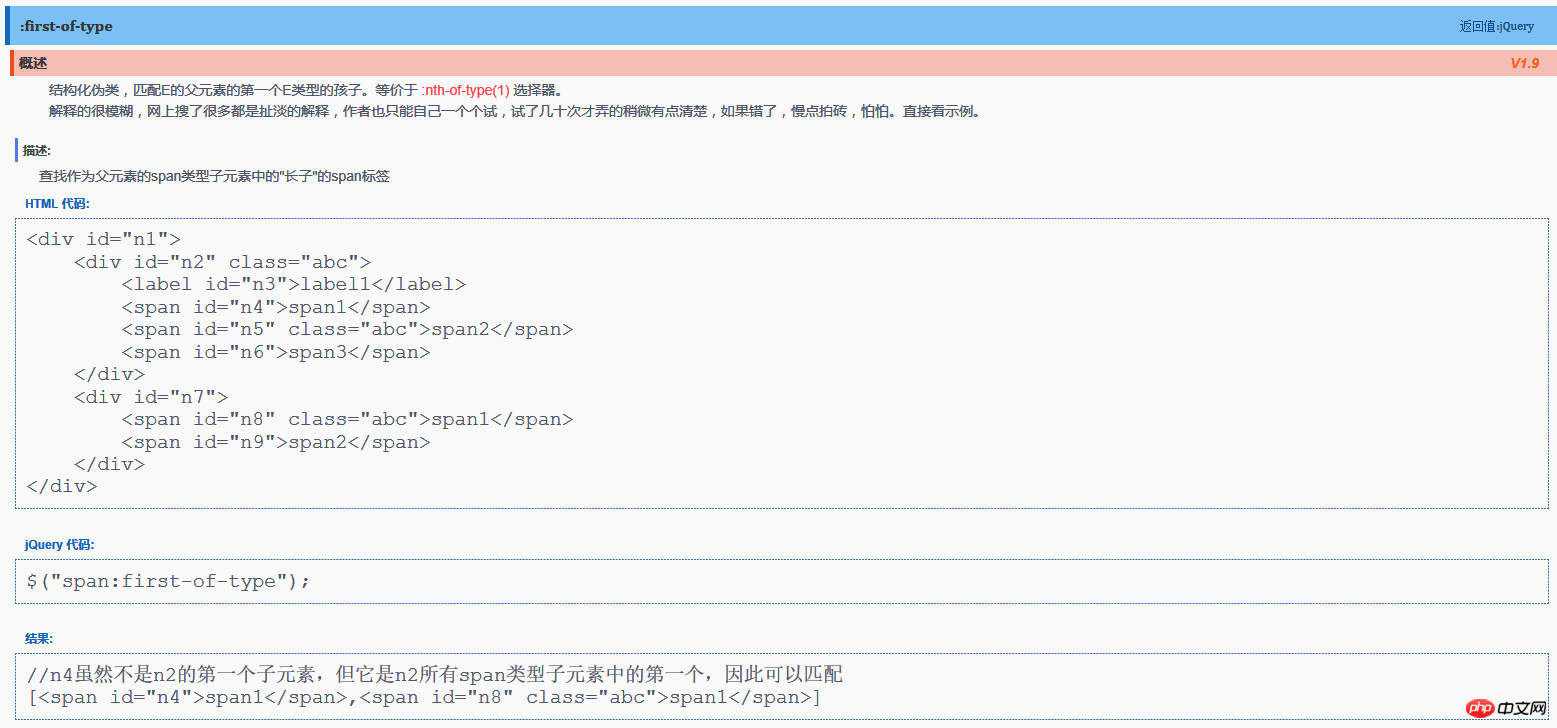
<!DOCTYPE html><html lang="zh-CN"><head>
<title>test</title>
<meta charset="utf-8">
<script src="./js/jquery-1.11/jquery.min.js"></script></head><body>
<p>
<ul>
<li><p>测试li-11</p></li>
<li><p>测试li-12</p></li>
<li><p>测试li-13</p></li>
</ul>
<hr>
<ul>
<li><p>测试li-21</p></li>
<li><p>测试li-22</p></li>
<li><p>测试li-23</p></li>
</ul>
<hr>
</p>
<hr>
<ul>
<li><p>测试li-31</p></li>
<li><p>测试li-32</p></li>
<li><p>测试li-33</p></li>
</ul>
<script>
$(document).ready(function(){
$("ul li:first").each(function(){
alert($(this).html());
})
}) </script></body></html>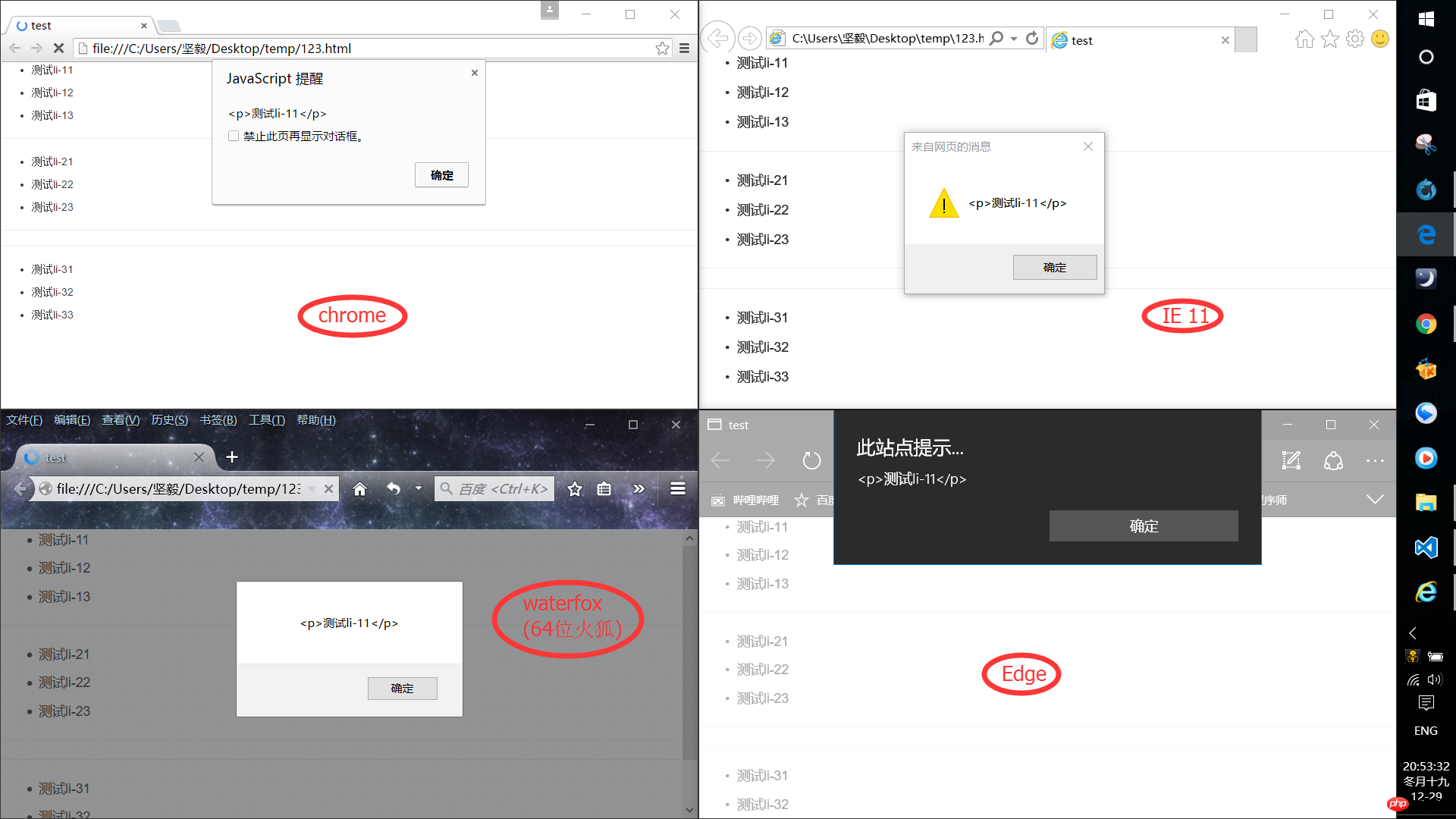
<!DOCTYPE html><html lang="zh-CN"><head>
<title>test</title>
<meta charset="utf-8">
<script src="./js/jquery-1.11/jquery.min.js"></script></head><body>
<p>
<ul>
<li><p>测试li-11</p></li>
<li><p>测试li-12</p></li>
<li><p>测试li-13</p></li>
</ul>
<hr>
<ul>
<li><p>测试li-21</p></li>
<li><p>测试li-22</p></li>
<li><p>测试li-23</p></li>
</ul>
<hr>
</p>
<hr>
<ul>
<li><p>测试li-31</p></li>
<li><p>测试li-32</p></li>
<li><p>测试li-33</p></li>
</ul>
<script>
$(document).ready(function(){
$("ul li:firstchild").each(function(){
alert($(this).html());
})
}) </script></body></html>
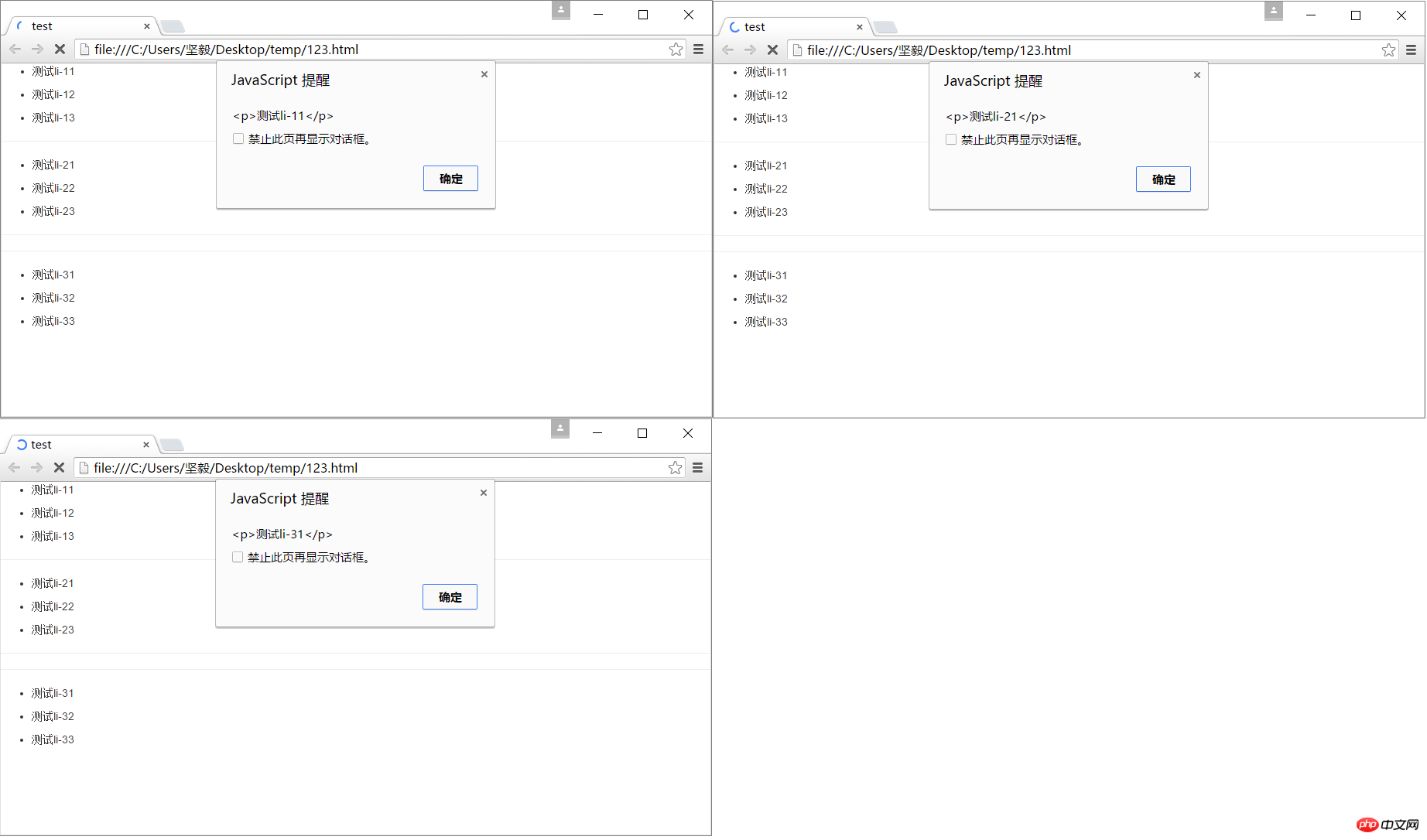
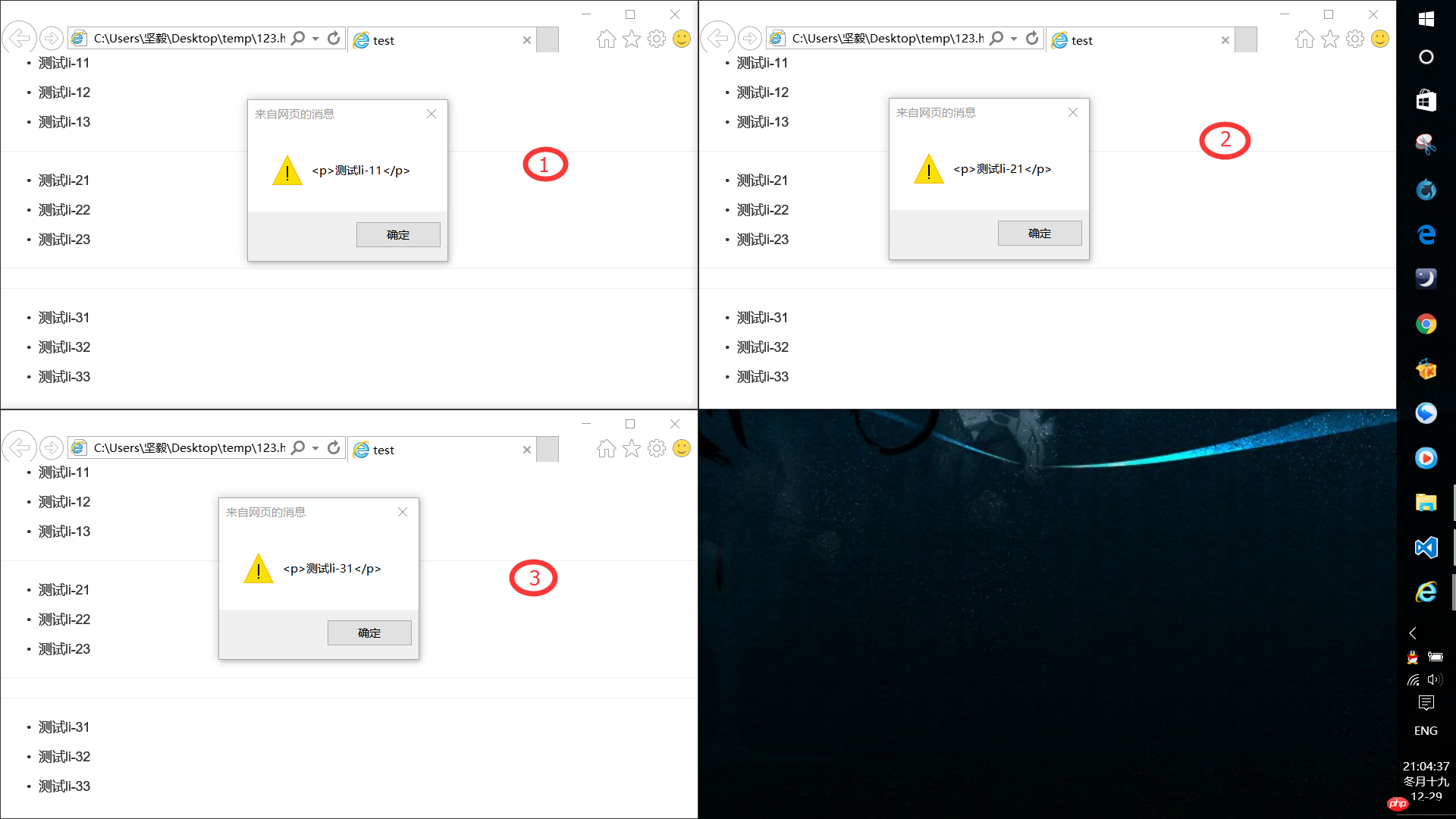 ## 【Edge】
## 【Edge】
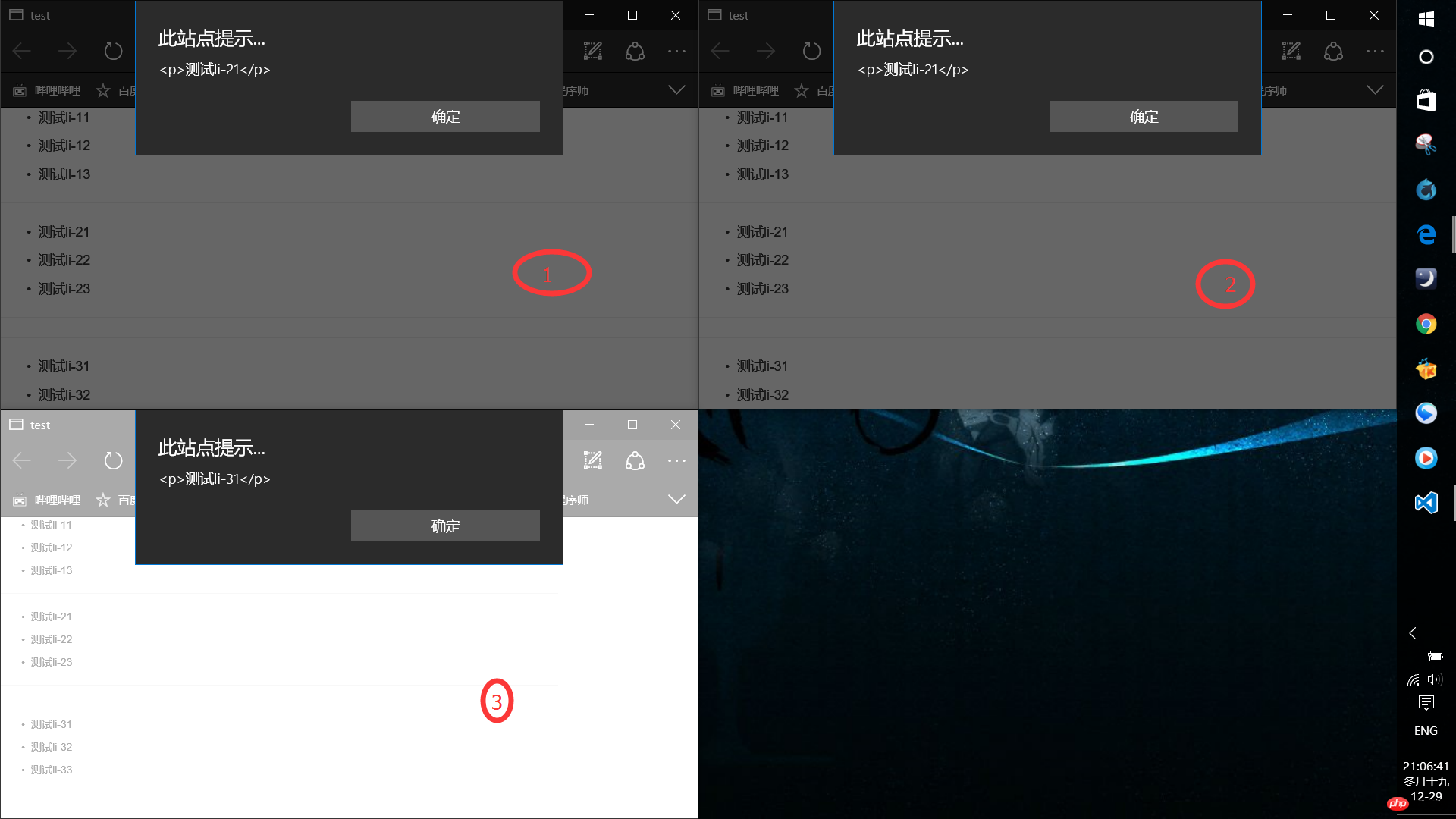 【:first-of-type】
【:first-of-type】
<!DOCTYPE html><html lang="zh-CN"><head>
<title>test</title>
<meta charset="utf-8">
<script src="./bootstrap/js/jquery-1.11/jquery.min.js"></script></head><body>
<p>
<ul>
<li><p>测试li-11</p></li>
<li><p>测试li-12</p></li>
<li><p>测试li-13</p></li>
</ul>
<hr>
<ul>
<li><p>测试li-21</p></li>
<li><p>测试li-22</p></li>
<li><p>测试li-23</p></li>
</ul>
<hr>
</p>
<hr>
<ul>
<li><p>测试li-31</p></li>
<li><p>测试li-32</p></li>
<li><p>测试li-33</p></li>
</ul>
<script>
$(document).ready(function(){
$("ul li:first-of-type").each(function(){
alert($(this).html());
})
}) </script></body></html>【:first-of-type selector display effect in each browser】
The display of this part is the same as that in [:first-child 】The effect is the same under the selector, but the length is reduced, and screenshots are still not included.
[Summary]
From the screenshot above, we can see that :first , :first-child , :first-of-type, these three selectors, browse The different processor cores will not affect jQuery and display effects.
On the other hand,
The [:first] selector returns a single node, that is, the node, which is unique and certain
【:first-child】The selector actually returns an array of nodes. If each is not used for traversal, the first node of the array is returned by default (later I checked the return value of size() , it is indeed 3, which confirms my idea)
[:first-of-type] selector, similar to [:first-child] (the reason why it is not the same is because the result is the same in this example , and the two selectors have different functions), and what is returned is also an array of nodes. If each is not used for traversal, the first node of the array is returned by default (later I checked the return value of size() , it is indeed 3, which confirms my idea).
PS: There seems to be a last corresponding to first. I haven’t seen it yet, but I personally feel that the two are the same, except that one is the first and the other is the last. It's the last one. If I have time, I will send the verification results of the last three selectors
The above is the detailed content of Detailed explanation of the difference between :first-child, :first and :first-of-type in jQuery selectors. For more information, please follow other related articles on the PHP Chinese website!

Hot AI Tools

Undresser.AI Undress
AI-powered app for creating realistic nude photos

AI Clothes Remover
Online AI tool for removing clothes from photos.

Undress AI Tool
Undress images for free

Clothoff.io
AI clothes remover

AI Hentai Generator
Generate AI Hentai for free.

Hot Article

Hot Tools

Notepad++7.3.1
Easy-to-use and free code editor

SublimeText3 Chinese version
Chinese version, very easy to use

Zend Studio 13.0.1
Powerful PHP integrated development environment

Dreamweaver CS6
Visual web development tools

SublimeText3 Mac version
God-level code editing software (SublimeText3)

Hot Topics
 1376
1376
 52
52
 Detailed explanation of jQuery reference methods: Quick start guide
Feb 27, 2024 pm 06:45 PM
Detailed explanation of jQuery reference methods: Quick start guide
Feb 27, 2024 pm 06:45 PM
Detailed explanation of jQuery reference method: Quick start guide jQuery is a popular JavaScript library that is widely used in website development. It simplifies JavaScript programming and provides developers with rich functions and features. This article will introduce jQuery's reference method in detail and provide specific code examples to help readers get started quickly. Introducing jQuery First, we need to introduce the jQuery library into the HTML file. It can be introduced through a CDN link or downloaded
 How to remove the height attribute of an element with jQuery?
Feb 28, 2024 am 08:39 AM
How to remove the height attribute of an element with jQuery?
Feb 28, 2024 am 08:39 AM
How to remove the height attribute of an element with jQuery? In front-end development, we often encounter the need to manipulate the height attributes of elements. Sometimes, we may need to dynamically change the height of an element, and sometimes we need to remove the height attribute of an element. This article will introduce how to use jQuery to remove the height attribute of an element and provide specific code examples. Before using jQuery to operate the height attribute, we first need to understand the height attribute in CSS. The height attribute is used to set the height of an element
 How to use PUT request method in jQuery?
Feb 28, 2024 pm 03:12 PM
How to use PUT request method in jQuery?
Feb 28, 2024 pm 03:12 PM
How to use PUT request method in jQuery? In jQuery, the method of sending a PUT request is similar to sending other types of requests, but you need to pay attention to some details and parameter settings. PUT requests are typically used to update resources, such as updating data in a database or updating files on the server. The following is a specific code example using the PUT request method in jQuery. First, make sure you include the jQuery library file, then you can send a PUT request via: $.ajax({u
 jQuery Tips: Quickly modify the text of all a tags on the page
Feb 28, 2024 pm 09:06 PM
jQuery Tips: Quickly modify the text of all a tags on the page
Feb 28, 2024 pm 09:06 PM
Title: jQuery Tips: Quickly modify the text of all a tags on the page In web development, we often need to modify and operate elements on the page. When using jQuery, sometimes you need to modify the text content of all a tags in the page at once, which can save time and energy. The following will introduce how to use jQuery to quickly modify the text of all a tags on the page, and give specific code examples. First, we need to introduce the jQuery library file and ensure that the following code is introduced into the page: <
 Use jQuery to modify the text content of all a tags
Feb 28, 2024 pm 05:42 PM
Use jQuery to modify the text content of all a tags
Feb 28, 2024 pm 05:42 PM
Title: Use jQuery to modify the text content of all a tags. jQuery is a popular JavaScript library that is widely used to handle DOM operations. In web development, we often encounter the need to modify the text content of the link tag (a tag) on the page. This article will explain how to use jQuery to achieve this goal, and provide specific code examples. First, we need to introduce the jQuery library into the page. Add the following code in the HTML file:
 How to tell if a jQuery element has a specific attribute?
Feb 29, 2024 am 09:03 AM
How to tell if a jQuery element has a specific attribute?
Feb 29, 2024 am 09:03 AM
How to tell if a jQuery element has a specific attribute? When using jQuery to operate DOM elements, you often encounter situations where you need to determine whether an element has a specific attribute. In this case, we can easily implement this function with the help of the methods provided by jQuery. The following will introduce two commonly used methods to determine whether a jQuery element has specific attributes, and attach specific code examples. Method 1: Use the attr() method and typeof operator // to determine whether the element has a specific attribute
 Understand the role and application scenarios of eq in jQuery
Feb 28, 2024 pm 01:15 PM
Understand the role and application scenarios of eq in jQuery
Feb 28, 2024 pm 01:15 PM
jQuery is a popular JavaScript library that is widely used to handle DOM manipulation and event handling in web pages. In jQuery, the eq() method is used to select elements at a specified index position. The specific usage and application scenarios are as follows. In jQuery, the eq() method selects the element at a specified index position. Index positions start counting from 0, i.e. the index of the first element is 0, the index of the second element is 1, and so on. The syntax of the eq() method is as follows: $("s
 Summary of commonly used file operation functions in PHP
Apr 03, 2024 pm 02:52 PM
Summary of commonly used file operation functions in PHP
Apr 03, 2024 pm 02:52 PM
目录1:basename()2:copy()3:dirname()4:disk_free_space()5:disk_total_space()6:file_exists()7:file_get_contents()8:file_put_contents()9:filesize()10:filetype()11:glob()12:is_dir()13:is_writable()14:mkdir()15:move_uploaded_file()16:parse_ini_file()17:



